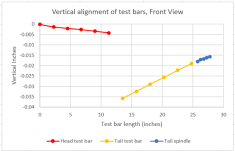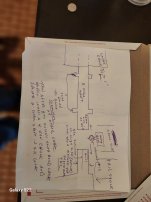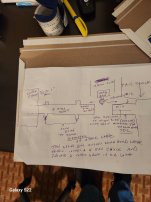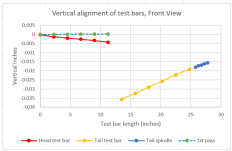The bed has been planed and scraped, Rulon added to the saddle. Now onto scraping and aligning the headstock and tailstock. The lathe came with collets and some chucks so I first tried to mount a 7" test bar and also a center in a collet. The lathe failed tests for runout. I did not know if the problem was the spindle taper or the collet system so I decided to build a test bar on another lathe. I got the taper machined to a good match to the spindle and then flipped the bar between centers to machine the strait section. This needed some filing to get diameter within about +/- 0.0001". When installed in the 10L spindle I still got +/- 0.0016 runout at the end. I removed the test bar, rotated it 90 degrees, and reinserted it. The high spot stayed at the same point on the test bar. As this was repeated, the high spot always followed the test bar instead of the spindle. I am convinced this means the problem is in the test bar and not the spindle internal taper. I guess I have some learning to do on the art of turning parts between centers.
For now I have marked a line down each side of the test bar that is at the mean of the maximum and minimum reading when rotating the spindle with the test bar. These lines are where all measurements will be done. My plan is to not install the bearing caps until the head is scraped into alignment with the bed? I can carry the bare head easily, if it was assembled I would need to use a hoist. I have a purchased test bar for the tailstock MT2 spindle. The photo shows both test bars installed in the lathe, they seem to be too long for a machine of this size, are there any guidelines for test bar length? Machine tool rebuilding makes note at one point that it should be related to lathe size but then lists specs only for a 12 inch bar. If there is a recommendation on test bar length for a 10" swing lathe, is it based on total bar length including the taper or just the length of the strait section?

I did some initial scrapeing on the 3 parts to get reasonable contact and improve alignment. (bottom of headstock and the tailstock top and bottom). Next I decided to map out the current state of the parts so I installed both test bars, mounted a dial gauge to the saddle cross slide and ran down the top of both test bars. At each measurement point I subtracted off 1/2 of the diameter of the test bar. The headstock center is about 0.015" higher than the tailstock, this seems like a lot of material to remove from the headstock with a hand scraper. Both the head and tail test bars point down by what seems a lot to me so I need to step scrape the outside of both to get the test bars horizontal or slightly pointing up.

I also measured the horizontal alignment by running the dial indicator down the front of both test bars. This is much better than the vertical. The ends of the test bars pointed slightly away from the front of the lathe and they need to be either parallel or tip slightly towards the front. You can also see that the test bar does not align perfectly with the tail stock spindle, I will have to check for repeatability of this. I think it is more important for the test bar to be pointing in the correct direction than the spindle outside diameter?

I realize I could probably improve alignment by stiffing shims of various thicknesses under the headstock and between the two halves of the tailstock. However I would like to rebuild it using as few shims as possible. Here is what I am thinking of doing.
1) Finish scrape in the bottom of the headstock to get the test bar pointing in the right direction in horizontal and vertical.
2) Roughly scrap the bottom of the tailstock to get its test bar parallel in the horizontal and vertical plane
3) Add rulon and glue to bottom of tailstock
4) Use a 4 jaw chuck on the headstock spindle to tweak the test bar alignment, add a small clamping force.
5) After cure make note of height difference between the now hopefully parallel test bars.
6) Move the bottom of the tailstock to the milling machine and machine the rulon strait down to within about 0.002" of its final
7) Finish scrape the rulon for alignment of the test bars.
I know this bypasses some steps in the rebuilding book but I guess I don't see the need to scrape the two halves of the tailstock into alignment to the lathe as long as they fit each other and the test bar is pointing in the right direction. One issue is the tailstock spindle only extends 2" and its surface shows some wear so it does not seem to be as reliable of a reference surface as the test bar.
I have also considered putting Rulon on the bottom of the headstock, mostly because it is so much easier to scrape than cast iron.
Open to suggestions
For now I have marked a line down each side of the test bar that is at the mean of the maximum and minimum reading when rotating the spindle with the test bar. These lines are where all measurements will be done. My plan is to not install the bearing caps until the head is scraped into alignment with the bed? I can carry the bare head easily, if it was assembled I would need to use a hoist. I have a purchased test bar for the tailstock MT2 spindle. The photo shows both test bars installed in the lathe, they seem to be too long for a machine of this size, are there any guidelines for test bar length? Machine tool rebuilding makes note at one point that it should be related to lathe size but then lists specs only for a 12 inch bar. If there is a recommendation on test bar length for a 10" swing lathe, is it based on total bar length including the taper or just the length of the strait section?

I did some initial scrapeing on the 3 parts to get reasonable contact and improve alignment. (bottom of headstock and the tailstock top and bottom). Next I decided to map out the current state of the parts so I installed both test bars, mounted a dial gauge to the saddle cross slide and ran down the top of both test bars. At each measurement point I subtracted off 1/2 of the diameter of the test bar. The headstock center is about 0.015" higher than the tailstock, this seems like a lot of material to remove from the headstock with a hand scraper. Both the head and tail test bars point down by what seems a lot to me so I need to step scrape the outside of both to get the test bars horizontal or slightly pointing up.

I also measured the horizontal alignment by running the dial indicator down the front of both test bars. This is much better than the vertical. The ends of the test bars pointed slightly away from the front of the lathe and they need to be either parallel or tip slightly towards the front. You can also see that the test bar does not align perfectly with the tail stock spindle, I will have to check for repeatability of this. I think it is more important for the test bar to be pointing in the correct direction than the spindle outside diameter?

I realize I could probably improve alignment by stiffing shims of various thicknesses under the headstock and between the two halves of the tailstock. However I would like to rebuild it using as few shims as possible. Here is what I am thinking of doing.
1) Finish scrape in the bottom of the headstock to get the test bar pointing in the right direction in horizontal and vertical.
2) Roughly scrap the bottom of the tailstock to get its test bar parallel in the horizontal and vertical plane
3) Add rulon and glue to bottom of tailstock
4) Use a 4 jaw chuck on the headstock spindle to tweak the test bar alignment, add a small clamping force.
5) After cure make note of height difference between the now hopefully parallel test bars.
6) Move the bottom of the tailstock to the milling machine and machine the rulon strait down to within about 0.002" of its final
7) Finish scrape the rulon for alignment of the test bars.
I know this bypasses some steps in the rebuilding book but I guess I don't see the need to scrape the two halves of the tailstock into alignment to the lathe as long as they fit each other and the test bar is pointing in the right direction. One issue is the tailstock spindle only extends 2" and its surface shows some wear so it does not seem to be as reliable of a reference surface as the test bar.
I have also considered putting Rulon on the bottom of the headstock, mostly because it is so much easier to scrape than cast iron.
Open to suggestions





